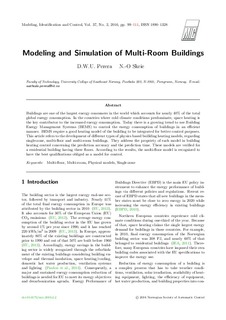| dc.contributor.author | Perera, Degurunnehalage Wathsala U. | |
| dc.contributor.author | Skeie, Nils-Olav | |
| dc.date.accessioned | 2017-02-27T15:00:05Z | |
| dc.date.accessioned | 2017-04-19T12:50:11Z | |
| dc.date.available | 2017-02-27T15:00:05Z | |
| dc.date.available | 2017-04-19T12:50:11Z | |
| dc.date.issued | 2016 | |
| dc.identifier.citation | Perera, D.W.U. & Skeie, N.O. (2016) Modeling and Simulation of Multi-Room Buildings. Modelinf identification and control, vol. 37, 99-111. | |
| dc.identifier.issn | 0332-7353 | |
| dc.identifier.uri | http://hdl.handle.net/11250/2438472 | |
| dc.description.abstract | Buildings are one of the largest energy consumers in the world which accounts for nearly 40% of the total global energy consumption. In the countries where cold climate conditions predominate, space heating is the key contributor to the increased energy consumption. Today there is a growing trend to use Building Energy Management Systems (BEMS) to control the energy consumption of buildings in an efficient manner. BEMS require a good heating model of the building to be integrated for better control purposes. This article refers to the development of different types of physics based buillding heating models, regarding single-zone, multi-floor and multi-room buildings. They address the propriety of each model in building heating control concerning the prediction accuracy and the prediction time. These models are verified for a residential building having three floors. According to the results, the multi-floor model is recognized to have the best qualifications obliged as a model for control. | |
| dc.language.iso | dan | |
| dc.subject | multi-floor | |
| dc.subject | multi-room | |
| dc.subject | physical models | |
| dc.subject | single-zone | |
| dc.title | Modeling and Simulation of Multi-Room Buildings | |
| dc.type | Journal article | |
| dc.type | Peer reviewed | |
| dc.description.version | Published version | |
| dc.identifier.doi | 10.4173/mic.2016.2.2 | |
